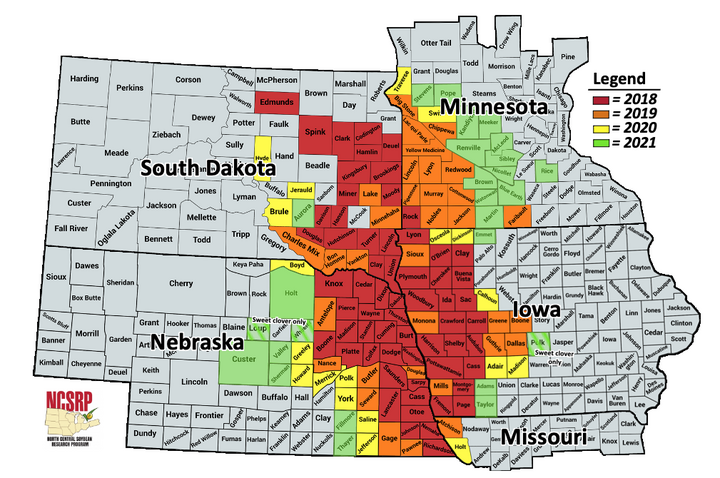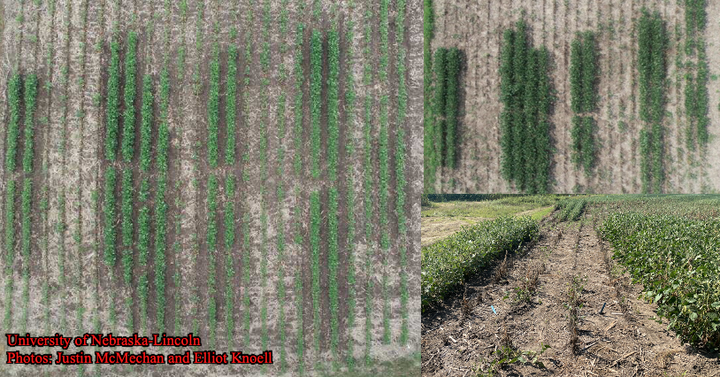General Observations
Soybean gall midge (SGM) injury and pressure varied considerably across its geographic range, with the largest concentration of injured soybean fields occurring in east-central Nebraska this season. To date, a total of 140 counties have been identified as infested with SGM through the presence of orange larvae on soybean and sweet clover. Of this total, 26 new counties were identified this year (Figure 1), with the largest number of new county detections occurring in Minnesota.

Nebraska Update
Soybean gall midge caused significant injury at all east-central Nebraska research sites in 2021. Adult emergence was first detected on May 31, with adult emergence from overwintering sites (last year’s soybean fields) and continued until July 21. The duration of adult emergence from overwintering sites is troubling for management with an average of 36 days across 14 sites in east-central Nebraska. This is longer than the 19- and 26-day average duration of overwintering emergence observed in 2019 and 2020, respectively.
Adult emergence from this year’s soybean was first detected on June 29, with consistent adult activity occurring during the season with the exception of Aug. 8 and 10. Based on the insects' lifecycle, it is likely that soybean gall midge completed two full generations on this year’s soybean. Adult activity has decreased over the past few days and is likely to end in early September, if it is similar to previous years.
A U.S. soybean germplasm field screen for SGM funded by the North Central Soybean Research Program (NCSRP) had significant pressure and presence of SGM this year. In east-central Nebraska, both research sites showed significant pressure with greater than 99.9% of plots infested with SGM. The significant injury and high frequency of infested plants provides an opportunity to identify potential sources of resistance to SGM in soybean. A wide variation in plant response to injury was observed in the field and additional analyses will be conducted this fall and winter.

A 2021 Nebraska Soybean Board funded planting date project evaluating larval number, plant injury and yield had significantly greater number of larvae on soybean planted on April 22 to May 12 compared to those planted on May 22 or June 1. Several other field projects on timing of foliar insecticides, seed treatments, at-plant insecticides and methods of foliar application are being conducted this year, with the full results shared this fall and winter. Studies on the biology and ecology to evaluate the movement of adults, seasonal larval abundance are also being conducted.
Of the field studies conducted, most notable was the identification of hilling (Figure 2) or covering the base of soybean plants early in the season as a potential strategy for soybean gall midge. This study was conducted at three sites in east-central Nebraska with easily observable differences in larval number and plant death. This strategy may be difficult for a number of growers to use but it highlights how essential the base of soybean plants are to insects' ability to cause significant injury.
Field surveys through funding from the NCSRP have identified six new counties in Nebraska with soybean gall midge on soybean. Two additional counties were identified with orange larvae found on sweet clover — a known host for soybean gall midge. No significant field injury from soybean gall midge was observed in these new counties. Several counties in east-central, as well as some fields in northeast Nebraska, showed considerable injury from soybean gall midge.
Current Management Considerations
- Identify this year’s SGM infested fields so possible management action can be planned for adjacent fields planted to soybean in 2022.
- If significant infestation has occurred in this year’s soybean fields, schedule the heaviest fields early in your harvest cycle to prevent harvest loss resulting from plant lodging or breakage.
Additional information as well as recorded presentations from a regional webinar last winter on SGM can be found on the Soybean Gall Midge Alert Network site.
